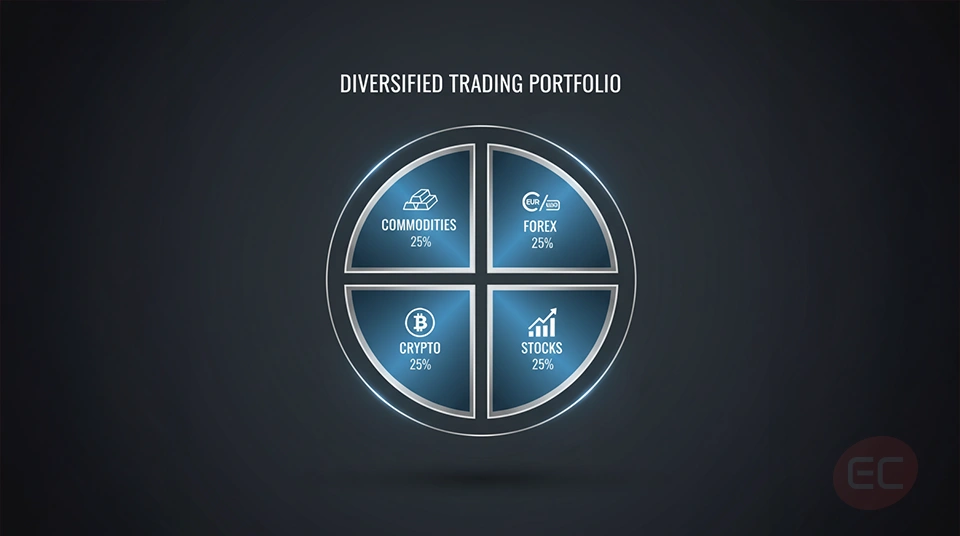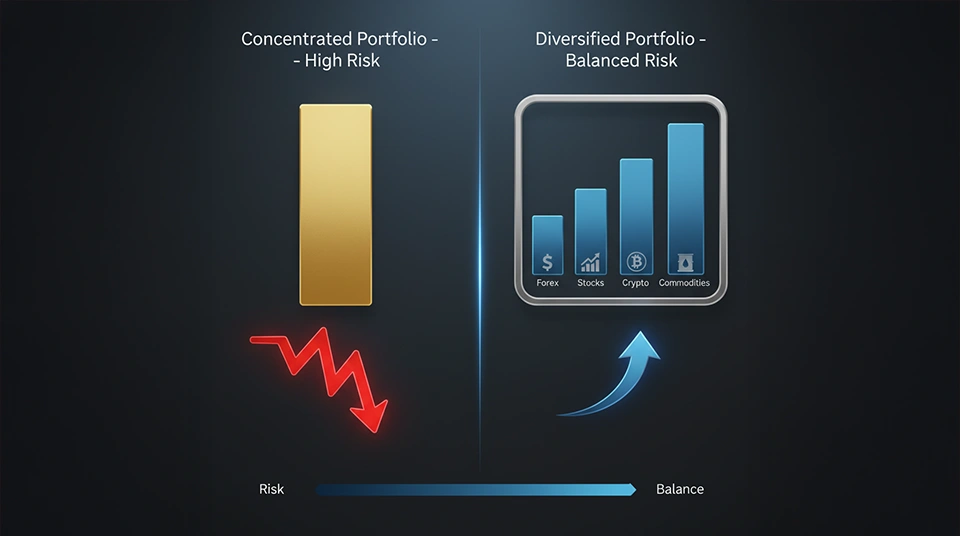How to Diversify Your Trading Portfolio for Lasting Results
We’ve all heard the saying before: "don't put all your eggs in one basket." But in the world of trading, that classic advice is even more relevant. Why? Because building a strong, resilient trading portfolio is the key to long term success. But what is portfolio diversification and what does it actually involve? In this course on how to build a trading portfolio, we are going to walk through the essentials of what is portfolio diversification, how it can protect you from unnecessary risks, and explore how to build a trading portfolio that can specifically handle unpredicted movement in the market. If you’ve ever wondered how to build a trading portfolio that actually lasts, it starts with understanding your risk tolerance and capital goals. Your portfolio trading decisions determine not just short-term profits, but how resilient your overall account remains through market swings. So whether you're into trading forex, stocks, crypto, a trading portfolio is crucial to your long term trading success. So let’s get started! First things first: what is portfolio diversification?

What is Portfolio Diversification and How does it shape a smarter Trading Portfolio?
Let’s start with the basics, but an essential question: what is portfolio diversification?
A simple definition of portfolio diversification means spreading your investments across multiple assets, strategies, or time frames. The main goal? A trading portfolio is built to reduce your risk by avoiding overexposure to a single asset or market. So how does this apply to your trading portfolio?
Let’s assume your entire trading portfolio depends on one pair, one stock, or one strategy, should the market decide to shift, any sudden move against you can cause serious damage and can be detrimental to your trading account. So diversification isn’t just about complicating your trading, quite the opposite in fact, it's about giving your capital a real safety net.
With portfolio diversification, your position is prepared to handle volatility more efficiently and will make sure to preserve capital even when some trades don't go as you had planned.
Why Diversification is so critical to a Trading Portfolio?
Imagine this scenario. Let’s say you're only trading gold, if gold suddenly drops 5% in one day, and if that's all you're trading, well, your trading portfolio takes the full hit. Now let’s look at the same scenario if you have a diversified portfolio. Imagine you're trading gold, tech stocks, Bitcoin, and the EUR/USD pair, and if gold drops, but tech stocks rise or EUR/USD moves in your favour, then the gains can offset the losses. That’s the power of using a trading portfolio. Once again, do not put all your eggs in one basket. Strong portfolio trading means being prepared for the unexpected, so that when one sector falls, another can rise to keep your results stable.
When you really understand what is portfolio diversification, you understand how it can protect you and how it can help you create balance. A good portfolio reduces risk and it allows your trading account to survive and even often thrive through periods of changing markets.
Building a Balanced Trading Portfolio
Now that you understand the importance of a strong trading portfolio, let’s go deeper. How to build a strong portfolio and how to diversify your trading portfolio? Let’s break it all down:
1. Asset Class Diversification
Number one rule to follow: do not put all your trades in one asset type, a well-diversified trading portfolio includes different markets, including:
- Forex pairs
- Stocks or indices
- Commodities like crude oil and gold
- Cryptocurrencies like Bitcoin or Ethereum
Assets react differently to global news and trends, that’s why this is a core step in how to build a trading portfolio that’s built to last. Remember, we are not suggesting you overload your portfolio with every asset, however, including some diversity is an absolute must.
2. Strategy Diversification
Strategy diversification. This is a step often overlooked by traders, but the truth is that some strategy diversification according to your assets can potentially protect you from again ‘putting all your eggs in one basket’. Within your trading portfolio, try to include some of the following strategies:
- Breakout strategies
- Trend following trades
- Mean reversion setups
- Momentum scalps
3. Time Frame Diversification
Contrary to popular belief, a strong trading portfolio isn’t just about what you trade, but it’s also when you trade it. When you’re mixing intraday trades with longer-term swing or position trades, you’re giving your portfolio trading strategy more flexibility and less dependency on short term outcomes.
How to Diversify your Trading Portfolio
Ok, now that you know the theory, let’s break down your trading portfolio into percentages.
Step 1: Define your Capital Allocation
Start by dividing your funds across different asset classes, a good example might include:
- Assign 30% to forex
- Assign 25% to stocks
- Assign 20% to crypto
- Assign 15% to commodities
- Assign 10% in cash or reserved capital
This is just an example, if there is a particular market you are more focused on depending on your end goal, you can opt to assign more of your funds to it, but make sure you are not putting all of your funds in one market.
Step 2: Select Markets that move differently
This is where what is portfolio diversification becomes real. A mistake that many traders seem to make is trading multiple assets that all react the same way to economic news. Let’s see an example, assuming you’re trading EUR/USD, GBP/USD, and AUD/USD, your trading portfolio is still highly correlated, because these pairs have a tendency to move in similar ways, so if the market moves against you, your portfolio is still at risk.
Instead, you should add variety in your trading portfolio, for example, try to include assets like: USD/JPY, gold, or tech stocks to give your portfolio trading structure more independence.
Step 3: Align your strategies with Market Behaviour
Different markets require different strategies, and understanding this allows you to:
- Assign the right strategy to each asset
- Reduce unnecessary risk
- Build a more reliable trading portfolio
This is a crucial part of how to build a trading portfolio, one that can adapt, thrive and most importantly, protect you in real time conditions.

Real World Example of a Diversified Trading Portfolio
Let’s look at a real world example of what is portfolio diversification in action and maybe use this as your base when diversifying your portfolio. Assuming your trading portfolio includes:
- Long EUR/USD
- Long Tesla stock
- Short oil futures
- Long Bitcoin
- Short S&P 500 index
If, all of a sudden, global news causes a sharp USD rally, then your EUR/USD long may lose but your short S&P 500 and oil trades could gain, and Bitcoin could hold steady or even move higher. What would be the result? Well, your trading portfolio essentially would stay balanced, because you diversified your portfolio enough to not relying on just one outcome. This example shows how thoughtful portfolio trading decisions help smooth out volatility across multiple assets.
Avoid these Mistakes when Portfolio Trading
Portfolio diversification is such an important part of your trading experience and yet, even experienced traders fall into traps. So let’s review what not to do when managing a trading portfolio, so you don’t make the same mistakes:
- Do not overload one sector, if you’re trading only tech stocks or only forex majors, you can be exposed to unnecessary risk
- Do not confuse multiple trades with diversification, there is a significant difference. A frequent issue in portfolio trading is neglecting correlation i.e. owning multiple assets that all react the same way. Five or six or even ten positions that move the same way are not the same as a diverse trading portfolio.
- Do not forget to review your portfolio, your plan should evolve monthly based on your performance and how the market shifts. Remember, trading is dynamic, so your portfolio should be growing as you analyse and observe the market behavior
Understanding how to build a trading portfolio is about being deliberate, and making calculated decisions based on technical and fundamental analysis, not just placing more and more trades.
Conclusion: Diversifying Your Portfolio
Congratulations on making it this far! By now, you should have a strong understanding of the importance of portfolio diversification and how to build a trading portfolio. Effective portfolio trading is a journey of learning, testing and improving your mix with every market cycle. If you can take away one thing from this course, it would be this: no one can predict markets perfectly, that’s why the best traders don’t rely on single trades or assets they rely on strategy, structure and strong portfolio diversification.
Now that you know what is portfolio diversification and exactly how to build a trading portfolio, what’s the next step? Well, if you’ve already built a portfolio, start by reviewing your current setup and ask yourself these questions:
- Are you overexposed to one market or asset class?
- Do you have multiple strategies at play?
- Is your risk evenly spread across your trading portfolio?
If you’re not confident with your trading portfolio, this is your signal to make a change. Use the information provided, take your time, and create a portfolio that can give you peace of mind!
We hope you enjoyed this important course on ‘diversifying your portfolio’! Are you ready for your next lesson? Then keep on reading the EC Markets Academy as we unlock new trading topics that will get you feeling like a confident trader in no time! See you at the next course!